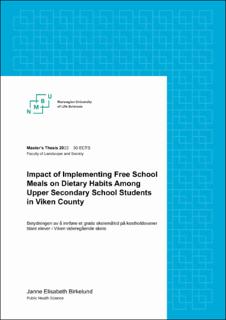| dc.description.abstract | Background:
Objective: The objective of this study was to investigate whether a free school meal had an impact on eating habits during school time among adolescents at upper secondary schools in Viken county. Breakfast and lunch habits, as well as consumption of fruit, vegetables, snacks, and various types of beverages, were examined.
Method: Data from The School Meal Survey conducted in 2021 and 2022 were used for analysis. The study included three schools that participated in the pilot project and were classified as intervention schools. Three control schools without school meals were selected to compare a possible change in dietary habits in the population. The sample at baseline consisted of 1,671 respondents. 837 were responses from the intervention schools, and 834 responses from students at the control schools. At follow-up, the sample consisted of 707 responses from the intervention group and 1273 responses from the control group (total n=1980). Cross-tabulation and a multilevel mixed model were used to analyze changes in eating habits. The outcome variables were breakfast and lunch frequency and fruit, vegetables, snacks, and beverages.
Results: No significant differences in eating habits were observed from 2021 to 2022 between the intervention and the control group. The fixed effects in the multilevel mixed model showed a small but positive change in breakfast frequency in the follow-up, among the intervention group, and in the time x school status interaction, indicating that school meals had a positive impact on students in the intervention schools and that the difference occurred at follow-up. Skipping breakfast was associated with lower SES and was more frequent among girls in both groups. No significant findings were observed for lunch frequency and diet scores.
Conclusion: The introduction of free school meals showed no significant improvement in the students' dietary habits. On the other hand, there are many factors and conditions that may have contributed to these findings. More studies should therefore be carried out investigating this issue.
Keywords: School meal, dietary habits, adolescence, public health | |

